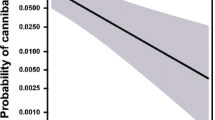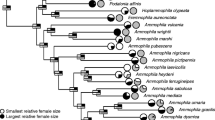Abstract
The balance between the investment of time and energy by males in searching for new partners and in protecting and/or feeding offspring can influence reproductive strategies. Strong competitors may enhance their mating effort, while weak competitors may compensate their disadvantage in intrasexual competition by investing in the increase of offspring survival. This balance and its implications to male reproductive strategies have been extensively investigated in vertebrate species but remain poorly understood in invertebrates, because paternal care is rare. Manogea porracea is the only described solitary spider in which extended male care occurs in the absence of females (i.e. amphisexual care). Large males usually win disputes and prefer large, more fecund females. Therefore, they may increase their reproductive success by prioritizing the investment in the search for additional partners, while small males may compensate their competitive disadvantage by increasing their own parental efforts. We tested the prediction that lighter males will invest in the care of the offspring more often than heavier ones. However, our results indicate that males care for offspring regardless of their size. We discuss how the benefits of parental care may override the costs of reducing the number of potential mates for M. porracea males and suggest new directions for further studies.


Similar content being viewed by others
References
Alissa LM, Muniz DG, Machado G (2017) Devoted fathers or selfish lovers? Conflict between mating effort and parental care in a harem-defending arachnid. J Evol Biol 30:191–201
Andersson M (1994) Sexual selection. Princeton University Press, New Jersey
Andrade MCB (1996) Sexual selection for male sacrifice in the Australian Redback spider. Science 271:70–72
Andrade MCB (2003) Risky mate search and male self-sacrifice in redback spiders. Behav Ecol 14:531–538
Bateman AJ (1948) Intra-sexual selection in drosophila. Heredity (Edinb) 2:349–368
Birkhead TR (1998) Sperm competition in birds: mechanisms and function. In: Birkhead TR, Moller AP (eds) Sperm competition and sexual selection. Academic Press, London, pp 578–622
Bollache L, Cézilly F (2004) Sexual selection on male body size and assortative pairing in Gammarus pulex (Crustacea: Amphipoda): field surveys and laboratory experiments. J Zool 264:135–141
Brockmann HJ, Taborsky M (2008) The evolution of alternative reproductive tactics: concepts and questions. In: Oliveira RF, Taborsky M, Brockmann HJ (eds) Alternative reproductive tactics: an integrative approach. Cambridge University Press, Cambridge, pp 25–51
Brockmann HJ (2008) Alternative reproductive tactics in insects. In: Oliveira RF, Taborsky M, Jane H (eds) Alternative reproductive tactics: an integrative approach. Cambridge University Press, Cambridge, pp 177–224
Burley NT, Hamedani E, Symanski C (2018) Mate choice decision rules: trait synergisms and preference shifts. Ecol Evol 8:2380–2394. https://doi.org/10.1002/ece3.3831
Busso JP, Davis Rabosky AR (2016) Disruptive selection on male reproductive polymorphism in a jumping spider, Maevia inclemens. Anim Behav 120:1–10
Christenson TE (1984) Alternative reproductive tactics in spiders. Am Zool 24:321–332
Crespi BJ (1989) Causes of assortative mating in arthropods. Anim Behav 38:980–1000
De Young S, Wilgers DJ (2016) The effects of male competition on the expression and success of alternative mating tactics in the wolf spider Rabidosa punctulata. J Arachnol 44:380–387
Edward DA, Chapman T (2011) The evolution and significance of male mate choice. Trends Ecol Evol 26:647–654
Forstmeier W (2002) Factors contributing to male mating success in the polygynous dusky warbler (Phylloscopus fuscatus). Behaviour 139:1361–1381
Forsyth A, Montgomerie RD (1987) Alternative reproductive tactics in the territorial damselfly Calopteryx maculata: sneaking by older males. Behav Ecol Sociobiol 21:73–81
Ghislandi PG, Pekár S, Matzke M et al (2018) Resource availability, mating opportunity and sexual selection intensity influence the expression of male alternative reproductive tactics. J Evol Biol 31:1035–1046
Griffith SC, Owens IPF, Thuman KA (2008) Extra pair paternity in birds: a review of interspecific variation and adaptive function. Mol Ecol 11:2195–2212
Gross MR (1991) Evolution of alternative reproductive strategies: frequency-dependent sexual selection in male bluegill sunfish. Philos Trans R Soc B Biol Sci 332:59–66
Hoefler CD (2007) Male mate choice and size-assortative pairing in a jumping spider, Phidippus clarus. Anim Behav 73:943–954
Janicke T, Haderer IK, Lajeunesse MJ, Anthes N (2016) Darwinian sex roles confirmed across the animal kingdom. Sci Adv 2:e1500983–e1500983
Klug H, Bonsall MB (2014) What are the benefits of parental care? The importance of parental effects on developmental rate. Ecol Evol 4:2330–2351
Kokko H, Jennions MD (2008) Parental investment, sexual selection and sex ratios. J Evol Biol 21:919–948
Kokko H, Johnstone RA (2002) Why is mutual mate choice not the norm? Operational sex ratios, sex roles and the evolution of sexually dimorphic and monomorphic signalling. Philos Trans R Soc B Biol Sci 357:319–330
Lackey ACR, Martin MD, Tinghitella RM (2018) Male competition and speciation: expanding our framework for speciation by sexual selection. Curr Zool 64:69–73
Magrath MJL, Komdeur J (2003) Is male care compromised by additional mating opportunity? Trends Ecol Evol 18:424–430
Marden JH (1989) Bodybuilding dragonflies: costs and benefits of maximizing flight muscle. Physiol Zool 62:505–521
Mitchell DP, Dunn PO, Whittingham LA, Freeman-Gallant CR (2007) Attractive males provide less parental care in two populations of the common yellowthroat. Anim Behav 73:165–170
Moller AP, Thornhill R (1998) Male parental care, differential parental investment by females and sexual selection. Anim Behav 55:1507–1515
Moura RR, Gonzaga MO (2017) Temporal variation in size-assortative mating and male mate choice in a spider with amphisexual care. Sci Nat 104:28
Moura RR, Vasconcellos-Neto J, de Gonzaga MO (2017) Extended male care in Manogea porracea (Araneae: Araneidae): the exceptional case of a spider with amphisexual care. Anim Behav 123:1–9
Neumann R, Schneider JM (2015) Differential investment and size-related mating strategies facilitate extreme size variation in contesting male spiders. Anim Behav 101:107–115
Peixoto PEC, Benson WW (2011) Fat and body mass predict residency status in two tropical satyrine butterflies. Ethology 117:722–730
Queller DC (1997) Why do females care more than males? Proc R Soc B Biol Sci 264:1555–1557
R Development Core Team R (2019) R: A language and environment for statistical computing
Requena GS, Machado G (2015) Effects of egg attendance on male mating success in a harvestman with exclusive paternal care. Behav Ecol 26:926–935
Rico-Guevara A, Hurme KJ (2018) Intrasexually selected weapons. Biol Rev 94:60–101
Segoli M, Arieli R, Sierwald P et al (2008) Sexual cannibalism in the brown widow spider (Latrodectus geometricus). Ethology 114:279–286
Trivers R (1972) Parental investment and sexual selection. In: Campbell B (ed) Sexual selection and the descent of man, 1871-1971. Aldine-Atherton, Chicago, pp 136–179
Vieira MC, Peixoto PEC (2013) Winners and losers: a meta-analysis of functional determinants of fighting ability in arthropod contests. Funct Ecol 27:305–313
Wright J (1998) Paternity and paternal care. In: Birkhead TR, Moller AP (eds) Sperm competition and sexual selection. Academic Press, London, pp 117–145
WSC (2018) World Spider Catalog. Version 19.0. In: Nat. Hist. Museum Bern
Yip EC, Rayor LS (2014) Maternal care and subsocial behaviour in spiders. Biol Rev 89:427–449
Acknowledgements
We thank MSc. Giancarlo Ângelo Ferreira and Yuri Lima Vasconcelos Ferreira for providing transport to the study area in several occasions. This project was supported Fundação de Amparo à Pesquisa do Estado de São Paulo (São Paulo Research Foundation, FAPESP: Proc. 14196-5/2017, 465562/2014-0), Duratex S.A., Coordenação de Aperfeiçoamento de Pessoal de Nível Superior (CAPES), Instituto Nacional de Ciência e Tecnologia dos Hymenoptera Parasitoides da Região Sudeste (HYMPAR/Sudeste - CNPq/CAPES/FAPESP), Fundação de Amparo à Pesquisa do Estado de Minas Gerais (FAPEMIG: Proc. APQ-02984-17, APQ-02104-14, CRA-30058/12, APQ-03202-13), and Conselho Nacional de Desenvolvimento Científico e Tecnológico (CNPq: Proc. 311823/2017-3; 403733/2012-0; 445832/2014-2; 465562/2014-0; 441225/2016-0).
Author information
Authors and Affiliations
Corresponding author
Additional information
Publisher’s Note
Springer Nature remains neutral with regard to jurisdictional claims in published maps and institutional affiliations.
Rights and permissions
About this article
Cite this article
Moura, R.R., Pinto, N.S., Vasconcellos-Neto, J. et al. Does Body Size Influence Male Care? Investigating an Alternative Reproductive Tactic in Manogea porracea (Araneae: Araneidae), a Spider with Amphisexual Care. J Insect Behav 32, 201–206 (2019). https://doi.org/10.1007/s10905-019-09725-w
Received:
Revised:
Accepted:
Published:
Issue Date:
DOI: https://doi.org/10.1007/s10905-019-09725-w




